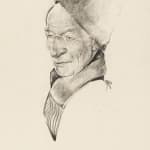Willem van den Berg (1886-1970)
Willem van den Berg, born on 16 February 1886 in The Hague, first trained with his father Andries van den Berg, a painter, printmaker and art teacher. Van den Berg enrolled at the local Art Academy and took study trips to Belgium, Italy, England, and France. One of his paintings was exhibited at the Jeu de Paume in Paris in 1926. In 1935, Van den Berg exhibited at the Art Institute of Chicago and continued to exhibit internationally throughout his career. By 1938, Van den Berg moved to Amsterdam, where he became the director of the National Academy of Fine Arts.
In the late nineteenth century, Volendam had become one of the most popular artists’ villages in Europe, popular with Monet, Signac, Renoir, and Picasso. Just eleven miles north of Amsterdam, Volendam even far into the twentieth century, remained frozen in time, untouched by modern life. The simplicity of the fishing community, wearing traditional costumes, living in tiny dollhouse-like wooden houses had an enormous appeal for artists and tourists alike. Van den Berg was not only attracted to the surroundings of the colorful fishing village on the former Zuiderzee sea, but also to its inhabitants. The local fishermen, their faces showing endurance and hardship across all seasons, became a source of inspiration for Van den Bergh throughout his career.
Rooted to the past by a refusal to don modern dress. the inhabitants are emblematic of a time that had all but vanished. Weather-beaten faces and powerful hands underline the harshness and endurance needed for life upon the sea. The sitters, paid models portrayed in their traditional costume, reoccur in different drawings. One of Van den Bergh’s most popular models was Frerik Schokker (1857-1943), known as grote (big) Frerik. Their outfits are predominantly black, with pants going back to seventeenth century sailors. The fur hat is worn in winter, as is the krawats, a black scarf, and of course, the famed wooden shoes.



